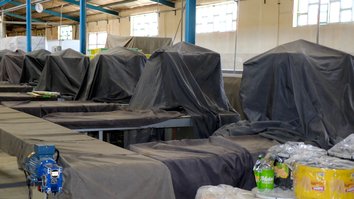SUKKUR -- A massive relief operation was under way Monday (August 29) and international donors began delivering aid as Pakistan struggled to deal with the worst monsoon flooding in over a decade.
Countless homes have been washed away, vital farmland destroyed and the country's main river threatening to burst its banks.
Officials say 1,061 people have died since June when the seasonal rains began, but the final toll could be higher as hundreds of villages in the mountainous north have been cut off after flood-swollen rivers washed away roads and bridges.
The annual monsoon is essential for irrigating crops and replenishing lakes and dams across the Indian subcontinent, but it can also bring destruction.
![Volunteers August 28 in Karachi carry relief food bags to load on a truck for flood survivors. [Rizwan Tabassum/AFP]](/cnmi_pf/images/2022/08/29/36851-000_32h92gj-585_329.jpg)
Volunteers August 28 in Karachi carry relief food bags to load on a truck for flood survivors. [Rizwan Tabassum/AFP]
This year's flooding has affected more than 33 million people -- one in seven Pakistanis, said the National Disaster Management Authority.
"What we see now is an ocean of water submerging entire districts," Climate Minister Sherry Rehman told AFP Monday.
"This is very far from a normal monsoon -- it is climate dystopia at our doorstep."
She called it "the monster monsoon of the decade".
This year's floods are comparable to 2010's -- the worst on record -- when more than 2,000 people died and nearly a fifth of the country was under water.
Landscape of water
Near Sukkur, a city in Sindh province and home to an ageing colonial-era barrage on the Indus river that is vital to preventing further catastrophe, one farmer lamented the devastation wrought on his rice fields.
Millions of acres of rich farmland have been flooded by weeks of non-stop rain, but now the Indus is threatening to burst its banks as torrents of water course downstream from tributaries in the north.
"Our crop spanned over 5,000 acres on which the best quality rice was sown and is eaten by you and us," Khalil Ahmed, 70, told AFP.
"All that is finished."
Much of Sindh is now an endless landscape of water, hampering a massive military-led relief operation.
"There are no landing strips or approaches available... our pilots find it difficult to land," one senior officer told AFP.
Across Sindh, thousands of displaced survivors are camped alongside elevated highways and railway tracks -- often the only dry spots as far as the eye can see.
More are arriving daily at Sukkur's city ring road, belongings piled on boats and tractor trolleys, looking for shelter until the floodwaters recede.
The army's helicopters were also struggling to pluck survivors to safety in the north, where steep hills and valleys make for treacherous flying conditions.
Many rivers in Khyber Pakhtunkhwa province -- which boasts some of Pakistan's best tourist spots -- have burst their banks, demolishing scores of buildings including a 150-room hotel that crumbled into a raging torrent.
"The house which we built with years of hard work started sinking in front of our eyes," said Junaid Khan, 23, the owner of two fish farms in Charsadda.
"We sat on the side of the road and watched our dream house sinking."
Pakistan as a whole has received twice the usual monsoon rainfall, but Balochistan and Sindh had more than four times the average of the last three decades, according to officials.
International aid
The government has declared an emergency and appealed for international help.
"I haven't seen destruction of this scale. I find it very difficult to put into words ... it is overwhelming," Foreign Minister Bilawal Bhutto-Zardari told Reuters, adding many crops providing much of the population's livelihoods had been wiped out.
"Obviously this will have an effect on the overall economic situation," he said.
The flooding could not have come at a worse time for Pakistan, where the economy is in free fall.
The International Monetary Fund (IMF) executive board was scheduled to meet in Washington on Monday to decide whether to green-light the resumption of a $6 billion loan programme essential for the country to service its foreign debt, but it is already clear the country will need more to repair and rebuild after this monsoon.
The prices of basic goods -- particularly onions, tomatoes and chickpeas -- are soaring as vendors bemoan a lack of supplies from the flooded breadbasket provinces of Sindh and Punjab.
The US government on August 16 announced it is providing $100,000 in immediate assistance to support Pakistanis affected by severe flooding through the US Agency for International Development (USAID).
The funds will "provide multi-purpose cash assistance to meet the immediate needs of the most-affected communities", it said.
Aid flights began arriving from Turkey and the United Arab Emirates (UAE) on Sunday.
Two Turkish planes carrying relief goods landed in Karachi on Sunday and another two planes loaded with relief goods are expected on Monday, according to Cemal Sangu, the Turkish consul general in Karachi.
The first Emirati relief aid plane arrived in Pakistan on Monday morning and will be followed by several more in the coming days, said UAE Ambassador to Pakistan Hamad Obaid al-Zaabi.
The aid includes about 3,000 tonnes of food supplies, medical and pharmaceutical items, and tents and shelter materials, The National reported Monday.

![A man walks over his collapsed mud house after heavy monsoon rains in Jaffarabad district, Balochistan province, on August 28. [Fida Hussain/AFP]](/cnmi_pf/images/2022/08/29/36855-000_32h873r-585_329.jpg)
![Pakistanis gather in front of a road damaged by floodwaters following heavy monsoon rains in the Madian area, Swat Valley, on August 27. [Abdul Majeed/AFP]](/cnmi_pf/images/2022/08/29/36856-000_32h76pm-585_329.jpg)
![An auto-rickshaw drives past temporary tents of survivors who fled their flood-hit homes set along a road in Sukkur, Sindh province, on August 27. Asif Hassan/AFP]](/cnmi_pf/images/2022/08/29/36857-000_32h77eh-585_329.jpg)
![A man carries his sick daughter along a road damaged by floodwaters following heavy monsoon rains in the Madian area, Swat Valley, on August 27. [Abdul Majeed/AFP]](/cnmi_pf/images/2022/08/29/36858-000_32h76ue-585_329.jpg)
![A woman distributes bags with relief items to displaced persons from flood-hit areas in Sindh province, in a school used as a temporary shelter in Karachi on August 27. [Rizwan Tabassum/AFP]](/cnmi_pf/images/2022/08/29/36859-000_32h772y-585_329.jpg)
![Shopkeepers after heavy monsoon rains collect their belongings from the mud outside their damaged shops in Mingora, Swat Valley, on August 27. [Abdul Majeed/AFP]](/cnmi_pf/images/2022/08/29/36860-000_32h73ay-585_329.jpg)
![Rescue workers help evacuate flood survivors from their homes following heavy monsoon rains in Rajanpur district of Punjab province on August 27. [Shahid Saeed Mirza/AFP]](/cnmi_pf/images/2022/08/29/36861-000_32h72ua-585_329.jpg)
![A man and a youth use a satellite dish to move children across a flooded area after heavy monsoon rainfalls in Jaffarabad district, Balochistan province, on August 26. [Fida Hussain/AFP]](/cnmi_pf/images/2022/08/29/36862-000_32h49mw-585_329.jpg)
![Pakistani army soldiers distribute relief food bags to flood survivors in Shikarpur of Sindh province on August 28. [Asif Hassan/AFP]](/cnmi_pf/images/2022/08/29/36863-000_32h92bv-585_329.jpg)
![Displaced survivors arrive on a tractor with their belongings at a makeshift camp after fleeing from their flood-hit homes following heavy monsoon rains in Sukkur, Sindh province, on August 29. [Asif Hassan/AFP]](/cnmi_pf/images/2022/08/29/36865-000_32h99xt-585_329.jpg)
![A displaced family prepares to install a tent at a makeshift camp after fleeing from its flood-stricken home following heavy monsoon rains in Sukkur, Sindh province, on August 29. [Asif Hassan/AFP]](/cnmi_pf/images/2022/08/29/36866-000_32h99yf-585_329.jpg)






